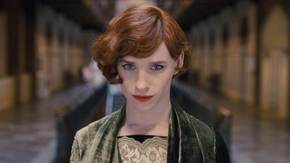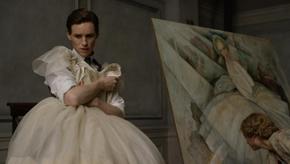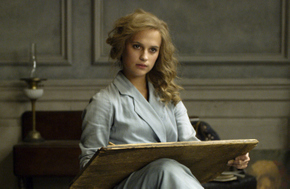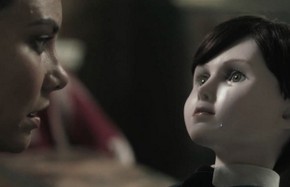 THE DANISH GIRL
THE DANISH GIRL
Yes, I’m reviewing director Tom Hooper’s The Danish Girl again, even though my previously published review is really all the film merits. (For those who missed it, the critique ran in my movies-of-2015 article under the “10 Least Favorites” header, and consisted of 19 words: “Everything irritating about period movies, ‘prestige’ movies, issue movies, and Eddie Redmayne all rolled into one carefully tucked package.”) Yet due, no doubt, to the four Oscar nominations the drama received, one of which it actually deserved, Hooper’s latest has finally landed on area screens, so I suppose a few more words are in order – just enough of them to purge the loathing I’ve felt for Hooper’s latest these past four weeks.
Opening in the Copenhagen of 1926, its true(ish) story tells of young marrieds Einar and Gerda Wegener (Redmayne and Alicia Vikander), the former a renowned painter of landscapes, the latter a struggling portrait artist. One day, when a female subject doesn’t show up for her session, Gerda asks Einar to wear the woman’s shoes and dress while Gerda sketches. Warily, but not too warily, he agrees. And for the remainder of the film’s length, we watch as the couple slowly, painfully comes to accept that Einar has been living a lie: that he’s actually a trans woman (one he christens “Lili”) determined to undergo gender-reassignment surgery. Filled with sensitivity, heartache, important themes, political correctness, and tears – so, so, so many tears – The Danish Girl is one of those movies that even non-admirers tend to let off on a pass for its “noble intentions.” But I’m not at all convinced that Hooper’s and screenwriter Lucinda Coxon’s intentions were so noble. If they were, the film wouldn’t be so sniggering, so pandering, or so deeply offensive.
I can only presume that everyone buying tickets for The Danish Girl knows its hook – that Redmayne will, for a goodly portion of his screen time, be in the guise of a woman. That’s why it’s particularly nauseating to find Coxon unable to stop nudging us in the ribs for our knowledge, as one line after another, during the movie’s first 20 minutes, grossly telegraphs the inevitable gender confusion. When Gerda reflects on her first kiss with Einar, she says, “It was the strangest thing – it was like kissing myself.” (Cue our silent responses of “Heh heh heh ... I’m sure it was!”) When a friend of the Wegeners speaks of the pair’s love, she says of Einar, “He’s only had eyes for one woman.” (“Heh heh heh ... that’s right ... one woman.”) When Einar, acting cagey, asks his wife is there’s anything about him she’d like to know, Gerda replies, “No, I’m your wife – I know everything.” (“Heh heh heh ... that’s what you think!”)
 But even after Einar comes out as Lili, Coxon’s dialogue – none of which would be out of place in The Spoils of Babylon – makes you cringe. I guess it was inevitable that we’d have to endure Lili, at her de facto coming-out party, being told with romantic ardor, “You’re different from most girls,” the potential suitor apparently awed by this stunning creature’s man hands, thick neck, and evident Adam’s apple. Did we really have to suffer through a hateful surgeon shouting at Gerda “You’re not encouraging this delusion?!” just so the easily outraged in the audience could revel in how much more enlightened they are than Danes in the ’20s were? Or Lili, pre-surgery, elocuting her situation with a florid “The doctor is curing me of this sickness that was my disguise”? Or Gerda, desperate to talk with her husband, being told by Lili, “Eilar can’t come out right now” like she’s Danny Torrance being possessed by “Tony” in The Shining?
But even after Einar comes out as Lili, Coxon’s dialogue – none of which would be out of place in The Spoils of Babylon – makes you cringe. I guess it was inevitable that we’d have to endure Lili, at her de facto coming-out party, being told with romantic ardor, “You’re different from most girls,” the potential suitor apparently awed by this stunning creature’s man hands, thick neck, and evident Adam’s apple. Did we really have to suffer through a hateful surgeon shouting at Gerda “You’re not encouraging this delusion?!” just so the easily outraged in the audience could revel in how much more enlightened they are than Danes in the ’20s were? Or Lili, pre-surgery, elocuting her situation with a florid “The doctor is curing me of this sickness that was my disguise”? Or Gerda, desperate to talk with her husband, being told by Lili, “Eilar can’t come out right now” like she’s Danny Torrance being possessed by “Tony” in The Shining?
Coxon makes The Danish Girl a chore to listen to. Gorgeous costumes aside, Redmayne makes it a chore to watch. The problem isn’t that he’s playing a woman; it’s that he’s playing a woman that any other woman would want to slap silly. There’s already something really unpleasant about the film’s conception of Einar, in that the artist appears to associate womanhood with only surface-level clichés of femininity: shy, coy glances; simpering body language; gentle caresses of skin and fabric. (In a scene that easily vies for the movie’s worst, Einar watches a peep-show stripper writhe and undulate while he mimics her languorous movements, learning how to be a “real” woman by imitating someone being paid to deliver a caricature of a woman.) Redmayne, though, never bothers to go below the surface – to explore what Einar’s identity as a woman means instead of merely what it looks like. God knows the script doesn’t offer him any assistance, yet Redmayne’s portrayal emerges as nothing but a series of showboating externals seemingly designed to make people (principally Oscar voters) applaud him for his technique and “bravery.” Lili may be a woman, but she’s a thunderously boring woman, all delicate mincing and proper, ladylike poses – the valedictorian of an unaccredited charm school.
 With her forthrightness and emotional transparency, Vikander easily out-acts Redmayne here. But then so do most of The Danish Girl’s background extras, and the cinematically omnipresent Vikander is hindered both by the insulting nature of her character and by Hooper’s insistence on shoving Gerda’s torment down our throats. (Gerda suffers one humiliation after another, and responds with dogged, unwavering encouragement that would shame the Felicity Jones of The Theory of Everything.) I’d say that about 80 percent of Vikander’s leading role – leading, not the Academy-approved “supporting” – finds her teary-eyed with quivering chin, and about 70 percent of Redmayne’s finds him in the same state, and all this tight-closeup angst proves overwhelming in the worst way. I could barely wait for someone else, anyone else, to enter Hooper’s claustrophobic picture, and nearly applauded when Matthias Schoenaerts showed up as a sympathetic art dealer who was also Einar’s childhood friend (and, we learn, once shared a kiss with the man). The scene in which he’s confronted by Lili and forced to pretend that he doesn’t know it’s Einar is an ungodly embarrassment, but Schoenaerts plays his discomfort so beautifully that I was at least grateful that a human being finally showed up on-screen.
With her forthrightness and emotional transparency, Vikander easily out-acts Redmayne here. But then so do most of The Danish Girl’s background extras, and the cinematically omnipresent Vikander is hindered both by the insulting nature of her character and by Hooper’s insistence on shoving Gerda’s torment down our throats. (Gerda suffers one humiliation after another, and responds with dogged, unwavering encouragement that would shame the Felicity Jones of The Theory of Everything.) I’d say that about 80 percent of Vikander’s leading role – leading, not the Academy-approved “supporting” – finds her teary-eyed with quivering chin, and about 70 percent of Redmayne’s finds him in the same state, and all this tight-closeup angst proves overwhelming in the worst way. I could barely wait for someone else, anyone else, to enter Hooper’s claustrophobic picture, and nearly applauded when Matthias Schoenaerts showed up as a sympathetic art dealer who was also Einar’s childhood friend (and, we learn, once shared a kiss with the man). The scene in which he’s confronted by Lili and forced to pretend that he doesn’t know it’s Einar is an ungodly embarrassment, but Schoenaerts plays his discomfort so beautifully that I was at least grateful that a human being finally showed up on-screen.
Between the stilted conversation and “Look how pretty and period-accurate I am!” decorousness of the production design, Hooper’s outing reeks of impeccable good taste and highbrow virtues; it’s the sort of movie that your grandma who doesn’t go to the movies would happily pay to see. (You might want to warn her, though, about the genital-tucking scene. And if that’s the path to Academy recognition, why didn’t The Silence of the Lambs’ Ted Levine get any?) Yet it’s also a lifeless, obvious, and maddening thing, boasting flourishes so ridiculous that, at my Chicagoland screening, I could barely suppress my giggles. I hate the film so much that I’m going to give away its final image, in which Alexandre Desplat’s exhaustingly melancholy music underscores the sight of one of Lili’s scarves being carried aloft by a soft breeze, floating and twirling just like the feather at the climax of Forrest Gump. The “refined,” “classy,” “nobly intentioned” The Danish Girl is indulgently awful. I’m a little bit shocked it’s not up for Best Picture, too.
 THE BOY
THE BOY
The legendary film critic Pauline Kael once wrote, “Scary-and-funny must be the greatest combination for popular entertainment,” and nothing in horror movies seems more custom-tailored to that description than the sub-genre of “evil doll-slash-ventriloquist’s-dummy.” Strangely, though, these tales almost never work in the scary-and-funny way you want them to, perhaps because they’re so inherently limiting; there’s really not much for you to do but stare at those faux humans and wait for the tiniest flickers of humanity to peek through. 1978’s Magic has some effective jolts (and a memorable dummy) but is pretty static, 2007’s Dead Silence falls apart quickly, 2014’s Annabelle is a dud; even the famed Child’s Play flicks were clunky before Chucky’s kitschy popularity led to them becoming intentionally clunky. But with director William Brent Bell’s The Boy, we may finally have a feature film that lives up to the promised fun of its ambulatory-plaything premise ... even if it, too, eventually leaves you less freaked out than mildly satisfied.
The Walking Dead’s Lauren Cohan plays Greta Evans, an American in hiding from an abusive beau who accepts a nanny position in London while the child’s parents are on extended holiday. Upon meeting the couple (Jim Norton and Diana Hardcastle), their advanced years make it hard to believe that they have an eight-year-old son, and the disbelief proves founded: Little Brahms, it turns out, is a porcelain doll whom his “parents” treat as alive. What you consequently expect to happen does happen – once Greta is left alone in the house with Brahms, scampering footsteps and faraway cries are heard, household items are moved or go missing, and Greta begins to think that she’s either losing her mind or Brahms is, in fact, real. But Bell displays a gift for quiet, elegant menace and positions Brahms for maximum eerieness, and Stacey Menear’s lean script is just evocative enough to give you occasional shivers. (My favorite line came when Brahms’ mother gave Greta a hug before departing and whispered in her ear, “I’m sorry.”) And despite the restrictive nature of the narrative, given the film’s one locale and its cast totaling all of eight, the storytelling boasts a fair number of surprises, even if the biggest one at the finale doesn’t make you go “Whoa!” so much as “Hmm ... okay, then.” Still, The Boy is a solid midwinter creep-out, buoyed to more-than-solid by the performances of Rupert Evans as a friendly grocer and, especially, Cohan, who’s so strong here that you don’t even feel badly about her spending so much of her screen-time conversing with nattily attired porcelain. Given the decaying company she keeps on AMC, I’m betting Cohan doesn’t feel badly about it, either.










